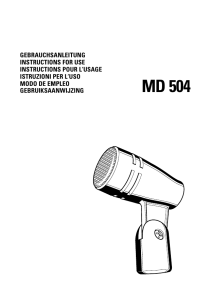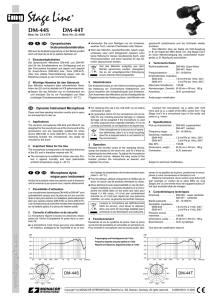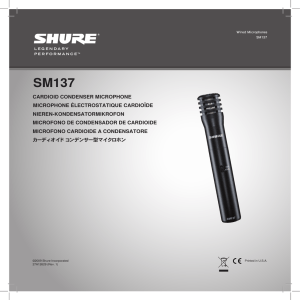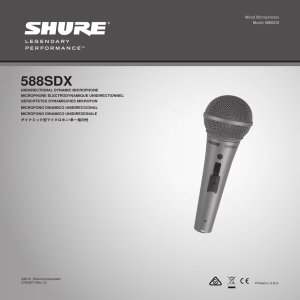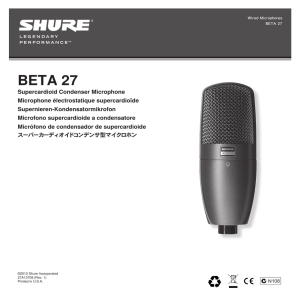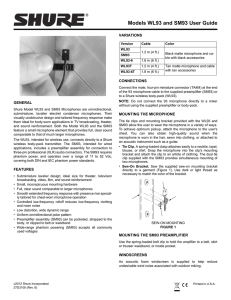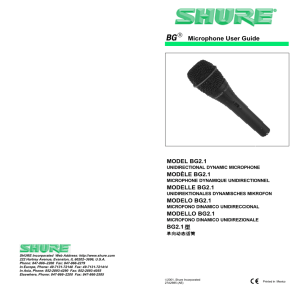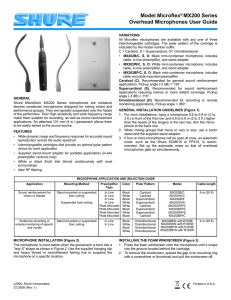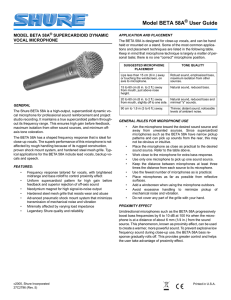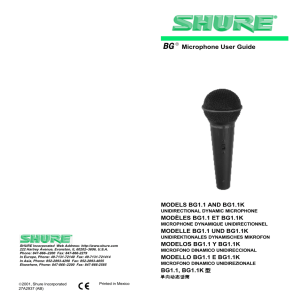Shure SM87A Microphones User Guide
Anuncio
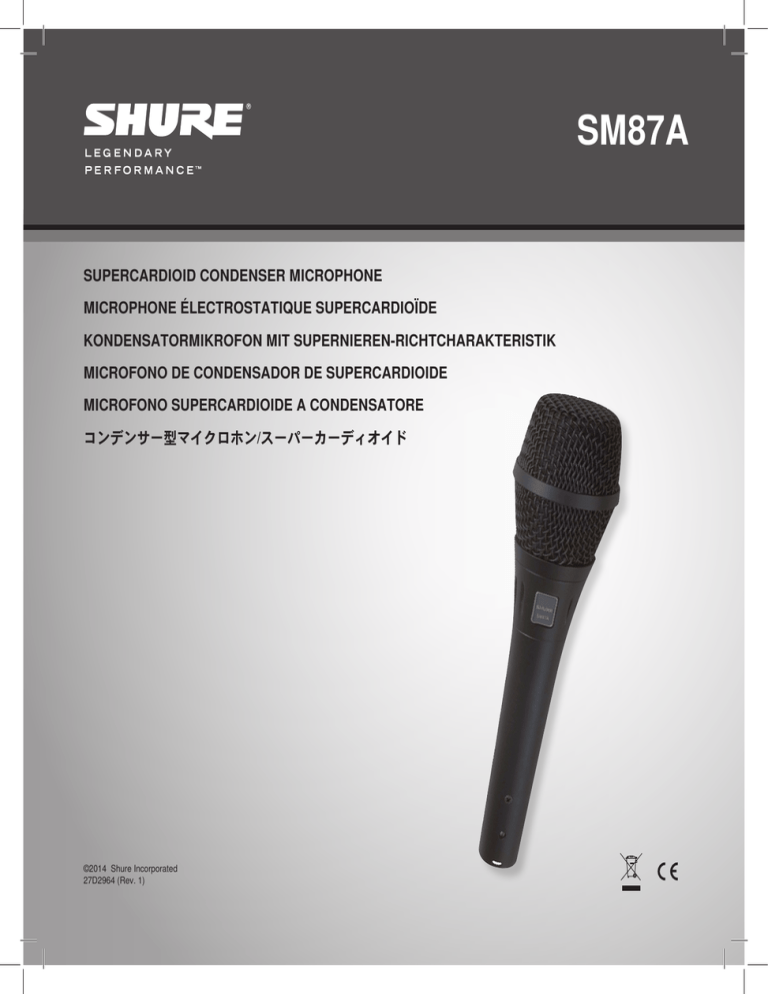
SM87A SUPERCARDIOID CONDENSER MICROPHONE MICROPHONE ÉLECTROSTATIQUE SUPERCARDIOÏDE KONDENSATORMIKROFON MIT SUPERNIEREN-RICHTCHARAKTERISTIK MICROFONO DE CONDENSADOR DE SUPERCARDIOIDE MICROFONO SUPERCARDIOIDE A CONDENSATORE コンデンサー型マイクロホン/スーパーカーディオイド ©2014 Shure Incorporated 27D2964 (Rev. 1) SM87A The Shure Model SM87A is a professional-quality, handheld condenser microphone for use in sound reinforcement, broadcasting, and studio recording installations. Its supercardioid polar pattern provides greater rejection of unwanted sound sources, making it ideal for miking individual instruments in a multi-microphone setting or for miking single sources in a reverberant or noisy environment. APPLICATIONS AND PLACEMENT The following table lists the most common applications and placement techniques. Keep in mind that microphone technique is largely a matter of personal taste; there is no one “correct” microphone position. SUGGESTED MICROPHONE PLACEMENT TONE QUALITY Lips less than 15 cm (6 in.) away or touching the windscreen, on axis to microphone. Robust sound, emphasized bass, maximum isolation from other sources. 15 to 60 cm (6 in. to 2 ft.) away from mouth, just above nose height. Natural sound, reduced bass. FEATURES 20 to 60 cm (8 in. to 2 ft.) away from mouth, slightly off to one side. • Uniform super-cardioid pick-up pattern for maximum gain before feedback and superior rejection of off axis sound Natural sound, reduced bass and minimal "s" sounds. 90 cm to 1.8 m (3 to 6 ft.) away. Thinner, distant sound; noticeable levels of ambient noise. The SM87A features a controlled low-frequency roll-off tailored for optimum performance when close-miking sound sources. An integral three-stage wind and pop filter protects against wind and breath noise. Its built-in shock mount reduces stand and handling noise. The SM87A operates on phantom power. APPLICATION Vocals • Smooth, wide frequency response with gradual presence rise and controlled proximity effect tailored for vocals • Steel mesh grille and satin finished aluminum construction resist wear and abuse • Very low susceptibility to RF and electromagnetic hum • Minimally affected be varying load impedances Proximity Effect • Performs over a wide range of temperature and humidity conditions Unidirectional microphones such as the SM87A progressively boost bass frequencies by 6 to 10 dB below 100 Hz when the microphone is at a distance of about 6 mm (1/4 in.) from the sound source. This phenomenon, known as proximity effect, can be used to create a warmer, more powerful sound. To prevent explosive low frequency sound during close-up use, the SM87A bass response gradually rolls off. This provides greater control and helps the user take advantage of proximity effect. • Phantom powered • Cartridge shock mount system absorbs mechanical shock and minimizes handling noise • Built in pop-filter reduces undesirable wind and breathe noise • Shure quality, ruggedness and reliability Power Condenser microphones such as the SM87A require phantom power supplied by a mixer, preamplifier, or console. Avoiding Pickup of Unwanted Sound Sources A supercardioid microphone has the greatest sound rejection at points 120° toward the rear of the microphone. Place the microphone so that unwanted sound sources, such as monitors and loudspeakers, are at these angles, not directly behind it. To minimize feedback and ensure optimum rejection of unwanted sound, always test microphone placement before a performance. General Rules for Use • Aim the microphone toward the desired sound source (such as the talker, singer, or instrument) and away from unwanted sources. • Place the microphone as close as practical to the desired sound source. P.A. LOUDSPEAKER MONITOR • Work close to the microphone for extra bass response. • Use only one microphone to pick up a single sound source. • Use the fewest number of microphones as practical. • Keep the distance between microphones at least three times the distance from each microphone to its source. • Place microphones as far as possible from reflective surfaces. • Add a windscreen when using the microphone outdoors. • Avoid excessive handling to minimize pickup of mechanical noise and vibration. • Do not cover any part of the microphone grille with your hand, as this will adversely affect microphone performance. RECOMMENDED LOUDSPEAKER LOCATIONS FOR SUPERCARDIOID MICROPHONES 3 SPECIFICATIONS ACCESSORIES AND PARTS Furnished Accessories Type Condenser (electret bias) Frequency Response 50 to 20,000 Hz Swivel Stand Adapter A25D Polar Pattern Supercardioid Carrying/Storage Bag 95A2313 Output Impedance EIA rated at 150Ω (100Ω actual) Sensitivity (at 1 kHz, open circuit voltage) −52 dBV/Pa (2.4 mV) 1 Pascal=94 dB SPL Maximum SPL (1 kHz at 1% THD, 1kΩ load) 140 dB Signal-to-Noise Ratio (referenced at 94 dB SPL at 1 kHz) 70 dB S/N ratio is difference between 94 dB SPL and equivalent SPL of self noise, A-weighted Dynamic Range (at 1 kHz, 1 kΩ load) 116.5 dB Clipping Level (1 kHz at 0.25% THD, 1kΩ load) −6 dBV (0.5 V) Self Noise (typical, equivalent SPL, A-weighted) 24 dB Polarity Positive pressure on diaphragm produces positive voltage on pin 2 with respect to pin 3 Weight Net: 0.20 kg (0.44 lbs) Connector Three-pin professional audio (XLR), male Case Aluminum construction with steel grille and satin black finish Power Requirements 11 to 52 Vdc phantom (1.2 mA) Optional Accessories Phantom Power Supply PS1A Shock Stopper™ Isolation Mount A55M Shock Stopper™ Isolation Mount A55HM Windscreen A85WS TRIPLE-FLEX™ Cable and Plug 7.6 m (25 ft.) C25F Replacement Parts Screen and Grille Assembly RK214G Cartridge R128 In-Line Preamplifier (1 piece) RPM626 CERTIFICATION Eligible to bear CE Marking. Conforms to European EMC Directive 89/336/EEC. Meets applicable tests and performance criteria in European Standard EN55103 (1996) parts 1 and 2, for residential (E1) and light industrial (E2) environments. 100 Hz 500 Hz, 1000 Hz 3150 Hz 610000 Hz +20 +10 dB 192 mm (7 9/16 in.) 21 mm (53/64 in.) 50.8 mm (2 in.) 1 cm (3/8 in.) 0 60.6 mm (2 ft.) –10 –20 2 20 4 50 100 3 4 5 6 7 89 1000 Hz 2 3 4 5 6 7 89 10000 20000 SM87A Le modèle SM87A de Shure est un microphone électrostatique à main de qualité professionnelle conçu pour la sonorisation, la radiodiffusion et les enregistrements en studio. Sa courbe de directivité supercardioïde assure un rejet supérieur des sources sonores indésirables, ce qui le rend idéal pour le captage d'instruments individuels dans une configuration à plusieurs microphones ou pour le captage de sources individuelles dans un environnement réverbérant ou bruyant. Le SM87A est doté d'une atténuation de basse fréquence contrôlée étudiée pour assurer les performances optimales lors du captage de près de sources sonores. Un filtre anti-pop et anti-vent à trois étages intégré protège contre les bruits de vent et de respiration. Sa monture silentbloc intégrée réduit les bruits provenant du pied et de la manipulation. Le SM87A utilise une alimentation fantôme. CARACTÉRISTIQUES • Configuration supercardioïde de captage uniforme pour assurer un gain maximum avant Larsen et un rejet supérieur des sons hors axe • Réponse en fréquence uniforme et large avec hausse de présence graduelle et effet de proximité contrôlé étudiés pour la voix • Grille en acier et construction en aluminium satiné résistant à l'usure et aux mauvais traitements • Très faible susceptibilité aux radiofréquences et aux ronflements électromagnétiques • Très peu affecté par les impédances de charge variables • Alimentation fantôme • Fonctionne dans des conditions de température et d’humidité variées • Système de monture silentbloc de capsule qui absorbe les chocs mécaniques et minimise les bruits de manipulation • Filtre anti-pop intégré qui réduit les bruits de vent et de respiration indésirables APPLICATIONS ET PLACEMENT Le tableau suivant répertorie les applications et techniques de placement les plus communes. Ne pas oublier que la façon d’utiliser un microphone est souvent une question de goût personnel et qu’il n’existe aucune position de microphone "correcte" à proprement parler. PLACEMENT SUGGÉRÉ DU MICROPHONE QUALITÉ DE LA TONALITÉ Lèvres à moins de 15 cm (6 po) de la bonnette anti-vent ou la touchant, dans l'axe du microphone. Son puissant, graves accentués, isolation maximum par rapport aux autres sources. 15 à 60 cm (6 po à 2 pi) de la bouche, juste au-dessus de la hauteur du nez. Son naturel, graves atténués. 20 à 60 cm (8 po à 2 pi) de la bouche, léger désaxage d'un côté. Son naturel, graves atténués et "sifflements" minimaux. Éloignement de 90 cm à 1,8 m (3 à 6 pi). Son plus ténu et distant, niveaux sensibles de bruit ambiant. APPLICATION Voix Effet de proximité Les microphones unidirectionnels tels que le SM87A augmentent progressivement les fréquences des graves de 6 à 10 dB en dessous de 100 Hz lorsque le microphone est éloigné de 6 mm (1/4 po) environ de la source sonore. Ce phénomène, appelé effet de proximité, peut être souhaité pour obtenir un son plus chaud et plus puissant. Pour empêcher un son "tonitruant" aux basses fréquences lors du captage de près, le SM87A atténue progressivement les graves. Cela permet un meilleur contrôle du son et aide l'utilisateur à profiter de l'effet de proximité. • Qualité, robustesse et fiabilité de Shure Alimentation Les microphones électrostatiques tels que le SM87A nécessitent une alimentation fantôme fournie par un mélangeur, un préamplificateur ou une console. Comment éviter le captage des sources sonores indésirables Un microphone à configuration supercardioïde a le rejet sonore le plus élevé à des pointes à 120° vers l'arrière du microphone. Placer le microphone de façon à ce que les sources sonores indésirables, telles que les retours de scène et les haut-parleurs, soient à ces angles et non directement derrière lui. Pour minimiser la contre-réaction acoustique et optimiser le rejet des sons indésirables, toujours essayer le placement du microphone avant une présentation. Règles générales d'utilisation • Diriger le microphone vers la source sonore désirée (telle qu'un orateur, un chanteur ou un instrument) et à l'opposé des sources sonores indésirables. • Placer le microphone le plus près possible de la source sonore. HAUT-PARLEUR DE SONORISATION RETOUR DE SCÈNE • Pour obtenir davantage de graves, placer le microphone le plus près possible de la source sonore. • Utiliser un seul microphone pour chaque source sonore. • Utiliser un minimum de microphones dans la mesure du possible. • La distance entre les microphones doit être d'au moins trois fois celle de chaque microphone à sa source. • Placer les microphones le plus loin possible des surfaces réfléchissantes. • Si le microphone est utilisé à l’extérieur, le munir d’une bonnette anti-vent. • Éviter de manipuler le microphone outre mesure afin de minimiser le captage des bruits mécaniques et des vibrations. • Ne couvrir aucune partie de la grille du microphone avec la main car cela dégradera les performances du microphone. EMPLACEMENTS RECOMMANDÉS DES HAUT-PARLEURS POUR LES MICROPHONES SUPERCARDIOÏDES 5 Caractéristiques ACCESSOIRES ET PIÈCES Accessoires fournis Type Électrostatique (polarisation d’électret) Réponse en fréquence 50 à 20.000 Hz Adaptateur de pied orientable Courbe de directivité Supercardioïde Sac de transport/rangement Impédance de sortie Nominale EIA à 150Ω (100Ω réelle) Sensibilité (à 1 kHz, tension en circuit ouvert) –52 dBV/Pa (2,4 mV) 1 Pascal=94 dB NPA NPA maximum (1 kHz avec DHT de 1 %, charge de 1 kΩ) 140 dB Rapport signal/bruit (mesuré à 94 dB NPA à 1 kHz) 70 dB Le rapport signal/bruit est la différence entre le NPA de 94 dB et le NPA équivalent du bruit propre pondéré en A Plage dynamique (à 1 kHz, charge de 1 kΩ) 116,5 dB Niveau d’écrêtage (1 kHz avec DHT de 0,25 %, charge de 1 kΩ) –6 dBV (0,5 V) Bruit propre (typique, équivalent NPA, pondéré en A) 24 dB Polarité Une pression acoustique positive sur le diaphragme produit une tension positive sur la broche 2 par rapport à la broche 3. Poids Net: 0,20 kg (0,44 lb) Connecteur Audio professionnel à trois broches (XLR), mâle Corps Construction en aluminium avec grille en acier et fini noir satiné Alimentation 11 à 52 V c.c. fantôme (1,2 mA) A25D 95A2313 Accessoires en option Bloc d’alimentation fantôme PS1A Monture d'isolement Shock Stopper™ A55M Monture d'isolement Shock Stopper™ A55HM Bonnette anti-vent A85WS Câble et fiche TRIPLE-FLEX™, 7,6 m (25 pi) C25F Pièces de rechange Écran et grille RK214G Capsule R128 Préampli en ligne (1) HOMOLOGATION RPM626 100 Hz 500 Hz, 1000 Hz Autorisé à porter la marque CE. Conforme à la directive CEM européenne 89/336/ CEE. Conforme aux critères applicables de test et de performances de la norme européenne EN55103 (1996) parties 1 et 2 pour les environnements résidentiels (E1) et d'industrie légère (E2). 3150 Hz 610000 Hz +20 +10 dB 192 mm (7 9/16 in.) 21 mm (53/64 in.) 50.8 mm (2 in.) 1 cm (3/8 in.) 0 60.6 mm (2 ft.) –10 –20 2 20 6 50 100 3 4 5 6 7 89 1000 Hz 2 3 4 5 6 7 89 10000 20000 SM87A Das Modell Shure SM87A ist ein Kondensator-Mikrofon zur Verwendung bei Beschallungs-, Rundfunk- und Tonstudioaufzeichnungsanlagen. Seine SupernierenRichtcharakteristik bewirkt größere Unterdrückung unerwünschter Schallquellen, wodurch es ideal für Mikrofonaufnahmen einzelner Schallquellen in lauter Umgebung Nebengeräuschen oder nachhall ist. Das SM87A weist einen Bassabsenkungs-Rolloff auf, der dem Nahbesprechungseffekt entgegen wirkt. Ein integrierter dreistufiger Wind- und Poppfilter schützt vor Wind- und Atemgeräuschen. Der eingebaute Erschütterungsabsorber verringert Stativgeräusche und Körperschall. Das SM87A wird mit Phantomspeisung betrieben. TECHNISCHE EIGENSCHAFTEN • Gleichförmige Supernierenrichtcharakteristik bietet maximale Rückkopplungssicherheit und ausgezeichnete Unterdrückung außeraxialer Schallquellen • Speziell auf Gesang zugeschnittener Frequenzgang mit Präsenzanhebung und Bassabsenkung zur Verminderung von Nahbesprechungseffekten. ANWENDUNG UND PLATZIERUNG In der folgenden Tabelle werden die gebräuchlichsten Anwendungen und Platzierungsverfahren aufgeführt. Dabei ist zu berücksichtigen, dass Mikrofontechnik im Grunde "Geschmackssache" ist; von der "einzig richtigen" Mikrofonstellung nicht die Rede sein kann. ANWENDUNG Gesang EMPFOHLENE MIKROFONPLATZIERUNG KLANGQUALITÄT Lippen weniger als 15 cm entfernt bis Lippenkontakt, axial zum Mikrofon. Druckvoller Klang, betonter Bass, maximale Trennung von anderen Schallquellen. 15 bis 60 cm vom Mund entfernt, unmittelbar über Nasenhöhe. Natürlicher Klang, verringerter Bass. 20 bis 60 cm vom Mund entfernt, etwas zur Seite versetzt. Natürlicher Klang, verringerter Bass und minimale Zischlaute. 90 cm bis 1,8 m entfernt. Dünnerer, entfernter Klang; wahrnehmbare Umgebungsgeräusche. • Korb aus Stahl- und Aluminiumkonstruktion widerstehen Verschleiß und rauen Anwendungen • Sehr geringe Anfälligkeit gegenüber Funkstörungen und elektromagnetischen Einflüssen • Nur geringfügige Beeinflussung durch variable Abschlussimpedanzen • Benötigt Phantomspeisung • Zuverlässige Funktion in einem großen Feuchtigkeits- und Temperaturbereich • Innovativer Kapsel-Erschütterungsabsorber minimiert mechanische Stöße und Körperschall • Eingebauter Poppfilter verringert unerwünschte Wind- und Atemgeräusche Nahbesprechungseffekt Richtmikrofone wie das SM87A verstärken tiefe Frequenzen unter 100 Hz um 6 bis 10 dB, wenn sich das Mikrofon in einem Abstand von etwa 6 mm vor der Schallquelle befindet. Diese Eigenschaft wird als Nahbesprechungseffekt bezeichnet und kann zum Erzeugen eines wärmeren, kräftigeren Klangs verwendet werden. Zur Verhinderung explosiver tieffrequenter Klänge bei Nahaufnahmen weist das SM87A einen Frequenzgang mit Hochpass auf. Dies bietet einen klareren Klang und hilft dem Benutzer, sich den Nahbesprechungseffekt zu Nutze zu machen. • Shure-Qualität, -Robustheit und -Zuverlässigkeit Vermeiden der Abnahme unerwünschter Schallquellen Phantomspeisung Kondensatormikrofone wie das SM87A erfordern Phantomspeisung durch einen Mischer, einen Vorverstärker oder eine Konsole. Supernierenmikrofone verfügen in einem Winkel von 120° zur Rückseite des Mikrofons über die größte Schallunterdrückung. Das Mikrofon so platzieren, dass unerwünschte Schallquellen, wie z. B. Monitore und Lautsprecher, in diesem Winkel undnicht direkt hinter dem Mikrofon angeordnet sind. Zur Minimierung von Rückkopplungen und zur maximalen Unterdrückung unerwünschter Geräusche die Mikrofonplatzierung vor einer Aufführung immer überprüfen. Allgemeine Regeln für den Gebrauch • Das Mikrofon auf die gewünschte Schallquelle (z. B. den Sprecher, Sänger oder das Instrument) und weg von unerwünschten Schallquellen richten. • Das Mikrofon so nahe wie möglich an der gewünschten Schallquelle platzieren. LAUTSPRECHER DER BESCHALLUNGSANLAGE MONITOR • Das Mikrofon sehr nahe platzieren, um eine zusätzliche Bassanhebung zu erzielen. • Nur ein Mikrofon zum Abnehmen einer einzelnen Schallquelle verwenden. • Die geringst mögliche Anzahl an Mikrofonen verwenden. • Den Abstand zwischen Mikrofonen mindestens dreimal so groß halten, wie den Abstand der Mikrofone zu der Schallquelle. • Mikrofone möglichst weit von akustischen Reflexionsflächen entfernt platzieren. • Bei Einsatz des Mikrofons im Freien einen Windschutz anbringen. • Das Mikrofon möglichst ruhig in der Hand halten, um mechanische Störgeräusche und Vibrationen minimal zu halten. • Keinen Teil des Mikrofonkorbs mit der Hand verdecken, da die Leistung des Mikrofons dadurch beeinträchtigt wird. AUFSTELLUNG DER LAUTSPRECHER FÜR SUPERNIERENMIKROFONE 7 TECHNISCHE DATEN ZUBEHÖRTEILE Mitgeliefertes Zubehör Typ Kondensatormikrofon (Elektret) Frequenzgang 50 bis 20.000 Hz Mikrofonklemme Richtcharakteristik Superniere Trage-/Aufbewahrungstasche Ausgangsimpedanz EIA-Zulassung bei 150Ω (100Ω Istwert) Empfindlichkeit (bei 1 kHz, Leerlaufspannung) –52 dBV/Pa (2,4 mV) 1 Pascal=94 dB Schalldruckpegel Maximaler Schalldruckpegel (1 kHz bei 1 % Gesamtklirrfaktor, 1 kΩ Last) 140 dB Signalrauschabstand (bezogen auf 94 dB Schalldruckpegel bei 1 kHz) 70 dB Signalrauschabstand ist die Differenz zwischen 94 dB Schalldruckpegel und dem äquivalenten Schalldruckpegel des Eigenrauschens mit Bewertungskurve A. A25D 95A2313 Sonderzubehör Dynamikbereich (bei 1 kHz, 1 kΩ Last) 116,5 dB Begrenzungspegel (1 kHz bei 0.25 % Gesamtklirrfaktor, 1 kΩ Last) –6 dBV (0,5 V) Eigenrauschen (typisch, entsprechender Schalldruckpegel, dB(A)) 24 dB Polarität Positiver Druck an der Membran erzeugt positive Spannung an Pin 2 in Bezug auf Pin 3. Gewicht Netto: 0,20 kg (0,44 lbs) Stecker Dreipoliger (XLR) Profi-Audiostecker Gehäuse Aluminiumkonstruktion mit Stahlgrill und seidenmatt glänzender schwarzer Oberfläche Versorgungsspannungen 11 bis 52 V DC Phantom (1,2 mA) Phantomspeisegerät PS1A Shock Stopper™-Schockabsorber A55M Shock Stopper™ Schockabsorber A55HM Windschutz A85WS TRIPLE-FLEX™-Kabel und Stecker, 7,6 m C25F Ersatzteile Korb mit Windschutz RK214G Kapsel R128 In-Line-Vorverstärker (1) RPM626 ZERTIFIZIERUNG Zur CE-Kennzeichnung berechtigt. Entspricht der europäischen Richtlinie zur elektromagnetischen Verträglichkeit 89/336/EWG. Erfüllt die Prüfungs- und Leistungskriterien der europäischen Norm EN 55103 (1996) Teil 1 und 2 für Wohngebiete (E1) und Leichtindustriegebiete (E2). 100 Hz 500 Hz, 1000 Hz 3150 Hz 610000 Hz +20 +10 21 mm (53/64 in.) 50.8 mm (2 in.) dB 192 mm (7 9/16 in.) 1 cm (3/8 in.) 0 60.6 mm (2 ft.) –10 –20 8 2 20 50 100 3 4 5 6 7 89 1000 Hz 2 3 4 5 6 7 89 10000 20000 SM87A El modelo SM87A de Shure es un micrófono de condensador de mano de calidad profesional para uso en refuerzo de sonido, difusión y grabaciones en estudio. Su patrón de captación de supercardioide proporciona un mejor rechazo de las fuentes sonoras no deseadas, haciéndolo ideal para la captación de instrumentos individuales en una situación que requiere el uso de varios micrófonos, o para captar una sola fuente en un entorno reverberante o ruidoso. El SM87A cuenta con una atenuación controlada de frecuencias bajas diseñada para ofrecer un rendimiento óptimo cuando se captan fuentes a poca distancia. Su filtro incorporado de tres etapas protege contra los ruidos producidos por el viento y el aliento. Su soporte amortiguado reduce los ruidos de escenario y de manipulación. El SM87A funciona con alimentación phantom. CARACTERISTICAS • Patrón de captación uniforme de supercardioide para una ganancia máxima antes de la realimentación y un rechazo superior de fuentes sonoras fuera de su eje • Respuesta de frecuencias uniforme y amplia con un aumento gradual en la presencia y control sobre el efecto de proximidad para la reproducción de voces USOS Y COLOCACION La tabla dada a continuación indica los usos y colocaciones más comúnmente empleados. Recuerde que la técnica de uso de los micrófonos es en gran parte cuestión de gusto personal: no existe una posición de micrófono que sea la “correcta”. USO Voces COLOCACION SUGERIDA DEL MICROFONO CALIDAD DEL TONO Los labios a no más de 15 cm (6 pulg) o tocando el paravientos, en línea con el eje de captación del micrófono. Sonido robusto, frecuencias bajas enfatizadas, aislamiento máximo de otras fuentes sonoras. De 15 a 60 cm (6 pulg a 2 pies) de la boca, justo por encima del nivel de la nariz. Sonido natural, frecuencias bajas reducidas. De 20 a 60 cm (8 pulg a 2 pies) de la boca, ligeramente a un lado de ésta. Sonido natural, frecuencias bajas reducidas y pocos sonidos sibilantes. De 90 cm a 1,8 m (3 a 6 pies) de distancia. Sonido más agudo y distante; niveles perceptibles de sonido ambiental. • La rejilla de acero y la fabricación de aluminio con acabado satinado resisten el desgaste y el maltrato • Muy baja sensibilidad a las radiofrecuencias (RF) y al zumbido electromagnético Efecto de proximidad • Alimentación phantom Los micrófonos unidireccionales tales como el SM87A introducen un aumento progresivo de 6 a 10 dB en las frecuencias bajas menores que 100 Hz cuando el micrófono se coloca a aprox. 6 mm (1/4 pulg) de la fuente sonora. Este fenómeno, conocido como el efecto de proximidad, puede usarse para crear un sonido más cálido y fuerte. Para evitar evitar sonidos de baja frecuencia con intensidad explosiva al usar el micrófono de cerca, el SM87A tiene una atenuación progresiva en su respuesta a bajos. Esto ofrece mayor control sobre el sonido y ayuda al usuario a aprovechar el efecto de proximidad. • Poco perturbado por variaciones en la impedancia de carga • Funciona en una amplia gama de condiciones de temperatura y humedad • El sistema de montaje amortiguado para la cápsula absorbe los choques mecánicos y reduce al mínimo el ruido de manipulación • El filtro de chasquidos incorporado reduce los sonidos producidos por el viento y el aliento • La calidad, durabilidad y confiabilidad de Shure Alimentación Los micrófonos de condensador tales como el SM87A requieren de alimentación phantom suministrada por la mezcladora, preamplificador o consola. Reglas generales de uso • Oriente el micrófono hacia la fuente sonora deseada (tal como un orador, cantante o instrumento) y aléjelo de las fuentes no deseadas. • Coloque el micrófono lo más cerca posible a la fuente sonora deseada. Cómo evitar la captación de fuentes sonoras no deseadas Los micrófonos de supercardioide ofrecen el rechazo más grande al sonido proveniente de puntos ubicados a 120° hacia la parte trasera del micrófono. Coloque el micrófono de forma que las fuentes sonoras no deseadas, tales como los micrófonos y altavoces, se encuentren a estos ángulos, no directamente detrás del micrófono. Para reducir al mínimo la realimentación de sonido y asegurar el rechazo máximo a los sonidos no deseados, siempre pruebe la colocación de los micrófonos antes de una presentación. ALTAVOZ DE SISTEMA DE SONIDO MONITOR • Acérquese al micrófono para obtener mayor respuesta de frecuencias bajas. • Utilice sólo un micrófono para captar una sola fuente sonora. • Utilice el menor número de micrófonos que resulte práctico. • La distancia entre un micrófono y otro deberá ser al menos tres veces la distancia de cada micrófono a su fuente. • Aleje los micrófonos lo más posible de las superficies reflectoras. • Instale un paravientos si se usa el micrófono a la intemperie. • Evite el manejo excesivo para reducir la captación de ruidos mecánicos y vibraciones. • No cubra parte alguna de la rejilla del micrófono con la mano, ya que esto tiene un efecto adverso sobre el rendimiento del micrófono. RECOMENDADAS PARA ALTAVOCES CON MICROFONOS DE SUPERCARDIOIDE 9 ESPECIFICACIONES ACCESORIOS Y PIEZAS Accesorios suministrados Tipo Condensador (electreto polarizado) Respuesta de frecuencia 50 a 20.000 Hz Adaptador giratorio para pedestal Patrón polar Supercardioide Bolsa de transporte/almacenamiento Impedancia de salida clasificado por EIA a 150Ω (100Ω real) Sensibilidad (a 1 kHz, voltaje en circuito abierto) –52 dBV/Pa (2,4 mV) 1 Pascal=94 dB SPL Nivel de presión acústica (SPL) máx. (1 kHz con 1% de distorsión armónica total, carga de 1 kΩ) 140 dB Relación de señal a ruido (con respecto a 94 dB SPL a 1 kHz) 70 dB La relación de señal a ruido es la diferencia entre 94 dB SPL y el SPL equivalente del ruido autógeno con ponderación A Rango dinámico (a 1 kHz, con carga de 1 kΩ ) 116,5 dB Nivel de limitación (1 kHz con 0,25% de distorsión armónica total, carga de 1 kΩ) –6 dBV (0,5 V) Ruido autógeno (SPL equivalente típico, ponderación A) 24 dB Polaridad Una presión positiva en el diafragma del micrófono produce un voltaje positivo en la clavija 2 con respecto a la clavija 3 Peso Neto: 0,20 kg (0,44 lb) Conector Conector de audio de tres clavijas profesional (tipo XLR), macho Estuche Fabricación de aluminio con rejilla de acero y acabado negro satinado Requisitos de alimentación 11 a 52 VCC phantom (1,2 mA) Accesorios opcionales Fuente de alimentación phantom PS1A Montaje aislado Shock Stopper™ A55M Montaje aislado Shock Stopper™ A55HM Paravientos A85WS Cable y enchufe TRIPLE-FLEX™, 7,6 m (25 pies) Conjunto de malla y rejilla RK214G Cápsula R128 Preamplificador en línea (1 pieza) RPM626 100 Hz 500 Hz, 1000 Hz Califica para llevar la marca CE. Cumple la directiva europea 89/336/EEC de compatibilidad electromagnética. Se ajusta a los criterios correspondientes de verificación y funcionamiento establecidos en la norma europea EN55103 (1996), partes 1 y 2, para zonas residenciales (E1) y zonas de industria ligera (E2). +10 dB 50.8 mm (2 in.) 3150 Hz 610000 Hz +20 192 mm (7 9/16 in.) 1 cm (3/8 in.) 0 60.6 mm (2 ft.) –10 –20 2 20 10 C25F Repuestos CERTIFICACIONES 21 mm (53/64 in.) A25D 95A2313 50 100 3 4 5 6 7 89 1000 Hz 2 3 4 5 6 7 89 10000 20000 SM87A Il modello Shure SM87A è un microfono da mano a condensatore, di qualità professionale, studiato per applicazioni di amplificazione, radiodiffusione e registrazione in studio. Il diagramma polare a supercardioide offre maggiore reiezione delle sorgenti sonore indesiderate, rendendolo ideale per l'installazione molto vicino a singoli strumenti in un impianto a microfoni multipli o per l'installazione molto vicino a singole sorgenti in un ambiente riverberante o rumoroso. Il modello SM87A offre attenuazione controllata alle basse frequenze, modellata espressamente per ottenere prestazioni ottimali in caso di installazione del microfono molto vicino alle sorgenti sonore. L'antivento a tre stadi ed il filtro antischiocco incorporati riducono i rumori del vento e della respirazione. Il supporto antivibrazioni incorporato riduce il rumore dovuto alle vibrazioni del sostegno ed agli spostamenti del microfono. Il modello SM87A funziona con alimentazione virtuale. CARATTERISTICHE • Diagramma di ricezione a supercardioide uniforme, che fornisce un guadagno elevato a monte della retroazione ed una reiezione superiore dei suoni fuori asse • Risposta in frequenza ampia e regolare, con aumento graduale quando esiste un effetto di presenza ed effetto di prossimità controllato, modellata espressamente per la riproduzione di segnali vocali • Griglia in acciaio e struttura in alluminio satinato resistenti all'usura ed agli abusi • Suscettività molto bassa all'interferenza a radiofrequenza e al ronzio elettromagnetico • Minima sensibilità a variazioni dell'impedenza di carico • Alimentazione virtuale • Utilizzabile in una vasta gamma di condizioni di temperatura e umidità • Sistema di montaggio antivibrazioni della capsula, che assorbe le sollecitazioni meccaniche e riduce al minimo il rumore generato maneggiando il microfono • Filtro antischiocco incorporato, che riduce i suoni indesiderati del vento e della respirazione APPLICAZIONI E COLLOCAZIONE La seguente tabella riporta le più comuni applicazioni e tecniche di collocazione. Tenete presente che non esiste un metodo "giusto" per disporre i microfoni; la loro collocazione dipende soprattutto dalle preferenze personali. APPLICAZIONE Cantanti COLLOCAZIONE SUGGERITA DEL MICROFONO QUALITÀ DEI TONI Bocca a meno di 15 cm di distanza oppure a contatto dell'antivento, in asse con il microfono. Suono robusto, enfasi dei toni bassi, massimo isolamento dalle altre sorgenti. Ad una distanza compresa tra 15 e 60 cm dalla bocca, appena sopra il livello del naso. Suono naturale, toni bassi ridotti. Ad una distanza compresa tra 20 e 60 cm dalla bocca, leggermente verso uno dei lati. Suono naturale, toni bassi ridotti e riduzione al minimo dei suoni sibilanti. Ad una distanza compresa tra 90 cm e 1,8 m. Suono meno percettibile, distante; livelli notevoli di rumore ambientale. Effetto di prossimità I microfoni unidirezionali, come il SM87A, amplificano progressivamente le frequenze basse di un valore compreso tra 6 e 10 dB (a livelli inferiori a 100 Hz) quando il microfono si trova ad una distanza di circa 6 mm dalla sorgente sonora. Questo fenomeno, noto come effetto di prossimità, può essere utilizzato per creare un suono più caldo e potente. Per prevenire suoni esplosivi a bassa frequenza quando il microfono è molto vicino alla sorgente sonora, la risposta del SM87A alle basse frequenze presenta un'attenuazione graduale. Si ottiene così un controllo migliore e si sfrutta più facilmente l'effetto di prossimità. • Qualità, robustezza ed affidabilità Shure Come evitare la ricezione di sorgenti sonore indesiderate Alimentazione L'area di maggiore reiezione del suono di un microfono supercardioide si trova a 120° verso la parte posteriore del microfono stesso. Posizionate il microfono in modo tale che eventuali sorgenti sonore indesiderate, quali apparecchi di monitoraggio ed altoparlanti, si trovino a tali angolazioni, non direttamente dietro di esso. Per ridurre al minimo il feedback e garantire la perfetta reiezione dei suoni indesiderati, verificare la prestazione del microfono nella posizione prescelta prima dello spettacolo. I microfoni a condensatore quali il SM87A richiedono alimentazione virtuale fornita da un mixer, un preamplificatore o una consolle. Regole generali per l'uso • Rivolgete il microfono verso la sorgente sonora desiderata (ad esempio, oratore, cantante o strumento) e lontano dalle sorgenti indesiderate. • Posizionate il microfono quanto più vicino possibile alla sorgente sonora da riprendere. APPARECCHIO DI MONITORAGGIO ALTOPARLANTE DELL'IMPIANTO PER IL PUBBLICO DEL PALCOSCENICO • Per ottenere un aumento della risposta alle basse frequenze, tenete il microfono vicino alla sorgente sonora. • Usate un solo microfono per ciascuna sorgente sonora. • Usate il minimo numero di microfoni possibile. • Mantenete la distanza tra i microfoni uguale ad almeno tre volte quella fra ciascun microfono e la relativa sorgente. • Tenete i microfoni quanto più lontano possibile da superfici riflettenti. • Se usate il microfono all'aperto, usate un antivento. • Cercate di spostare il microfono quanto meno possibile, per ridurre al minimo la ricezione di vibrazioni e rumore meccanico. • Non coprite nessuna parte della griglia del microfono con la mano, per non comprometterne le prestazioni. CONSIGLIATE DEGLI ALTOPARLANTI PER I MICROFONI SUPERCARDIOIDE 11 SPECIFICHE TECNICHE ACCESSORI E PARTI DI RICAMBIO Accessori in dotazione Tipo A condensatore (polarizzazione a elettrete) Risposta in frequenza 50 a 20.000 Hz Adattatore per sostegno girevole Diagramma polare Supercardioide Custodia (adatta anche per il trasporto) Impedenza di uscita Valore nominale EIA 150Ω (100Ω effettivo) Sensibilità (a 1 kHz, tensione a circuito aperto) –52 dBV/Pa (2,4 mV) 1 Pascal=94 dB di SPL Livello di pressione sonora (SPL) massimo (1 kHz a 1% di THD, carico di 1 kΩ) 140 dB Rapporto segnale/rumore (riferito a 94 dB di SPL a 1 kHz) 70 dB Il rapporto segnale/rumore è la differenza tra un SPL di 94 dB e l’SPL equivalente del rumore generato internamente e misurato con filtro di ponderazione A Gamma dinamica (a 1 kHz, carico di 1 kΩ) 116,5 dB Livello di clipping (1 kHz a 0,25% di THD, carico di 1 kΩ) –6 dBV (0,5 V) Rumore generato internamente (valore tipico, SPL equivalente, filtro di ponderazione A) 24 dB Polarità Una pressione positiva sul diaframma produce una tensione positiva sul piedino 2 rispetto al piedino 3. Peso Netto: 0,20 kg (0,44 lbs) Connettore Tipo audio, professionale, a tre piedini (XLR), maschio Involucro In alluminio, con griglia in acciaio inossidabile e finitura nero satin Alimentazione 11 a 52 V c.c. phantom (1,2 mA) A25D 95A2313 Accessori in opzione Alimentatore phantom PS1A Sostegno isolante antivibrazioni Stopper™ A55M Sostegno isolante antivibrazioni Stopper™ A55HM Antivento A85WS Cavo e spina TRIPLE-FLEX™ da 7,6 m (25 piedi) C25F Parti di ricambio Gruppo schermo e griglia RK214G Cartuccia R128 Preamplificatore in linea (1) RPM626 100 Hz 500 Hz, 1000 Hz OMOLOGAZIONI Contrassegnabile con il marchio CE. Conforme alla direttiva europea sulla compatibilità elettromagnetica 89/336/CEE. Soddisfa i criteri di prestazione e le verifiche pertinenti specificati nella norma europea EN55103 (1996) parti 1 e 2 relativa ad ambienti domestici (E1) e industriali leggeri (E2). 3150 Hz 610000 Hz +20 +10 dB 192 mm (7 9/16 in.) 21 mm (53/64 in.) 50.8 mm (2 in.) 1 cm (3/8 in.) 0 60.6 mm (2 ft.) –10 –20 2 20 12 50 100 3 4 5 6 7 89 1000 Hz 2 3 4 5 6 7 89 10000 20000 SM87A Shure Model SM87Aはプロクオリティのハンドヘルド式コンデンサ型マイクロホンで、 サウンド 補正や放送、 スタジオレコーディングに適します。 スーパーカーディオイド特性は、 不要な音源を カットし、複数のマイクが設置されている環境での個別楽器の収音や、残響や雑音が多い環 境での単一音源の収音に最適です。 SM87Aは、音源を近接して収音する際に最適なパフォーマンスが得られる、 コントロールされた 低域ロールオフが特徴です。一体化された3層構造のウィンドおよびポップフィルタが、 ウィンド ノイズやブレスノイズから保護します。内蔵ショックマウントはマイクスタンドのノイズやハンド リングノイズを抑制します。SM 87Aはファンタム電源で作動します。 用途と配置 一般的な使用用途と設置方法については下記の表をご参照ください。 ただし、 マイクロホンの 設置方法は何通りもあり、人それぞれの好みや感じ方によって異なるため、 いわゆる 「正解」 と いうものはありません。 用途 ボーカル 機能 マイクロホンの推奨配置 音質 唇をマイクロホンの中心軸上、15 cm 以内に近づけるか、 ウインドスクリーン に触れます。 低音域が強調された力強い 音質で、 その他の音源を最 大限に分離します。 口から15~60 cm 離し、 ちょうど鼻の上 の高さに配置します。 自然な音質、抑えた低音。 口から20~60 cm 離し、横に少しずら します。 自然な音質、抑えた低音。 ヒ スノイズを抑えます。 90 cm~1.8 m離します。 遠くから聞こえる細い音。環 境雑音が聞こえる程度。 • 均一なスーパーカーディオイド特性により、広いフィードバックマージンの確保と、収音軸を 外れた時の音質劣化を防止 • 段階的なプレゼンスライズがあるスムーズな幅広い周波数特性で、 ボーカル用に的確にコ ントロールされた近接効果 • 衝撃や長期使用に耐える、 スチールメッシュグリルとサテン仕上げのアルミニウム製ボティ • RFや電磁ハムによる影響は最小限 • 負荷インピーダンス変動による影響は最小 • ファンタム電源 • 広範囲な温度や湿度条件で動作 • カードリッジのショックマウントシステムがメカニカルショックを吸収し、 ハンドリングノイズ を低減 • ポップフィルタを内蔵し、 ウィンドノイズやブレスノイズを削減 近接効果 単一指向性マイクロホン (例えばSM87A ) は、音源に約6 mmまで近づくと、100 Hz以下で6 ~10 dBほど低音域が次第に上昇します。近接効果といわれるこの現象は、 よりパワフルで心 地よい音を生み出すために使用できます。 クローズアップでの使用中に低周波の破裂音を防 止するため、SM87A 低周波レスポンスは段階的にロールオフします。 これにより、近接効果を 上手くコントロールして活用することができます。 • Shureの卓越した品質・耐久性・信頼性 不要な音源を拾わないようにするために 電源 コンデンサ型マイクロホン (例えば、SM87A ) は、 ミキサまたはプリアンプ、 コンソールから供給 されるファンタム電源が必要です。 スーパーカーディオイド・マイクロホンはマイクロホン背面方向120° の角度で音を最大に抑制 します。 モニターやラウドスピーカーなどの不要な音源は、 マイクロホンの真後ろではなく、 この 角度にくるように設置してください。 フィードバックを抑えて不要な音源を最大限に抑制するた め、 パフォーマンスの前にマイクロホン配置テストを必ず実行してください。 使用時の原則 • マイクロホンは意図する音源(話者、 シンガー、楽器など) に向け、不要な音源から遠ざける ようにしてください。 P.A.ラウドスピーカー モニター • マイクロホンを音源のできるだけ近くに配置してください。 • 低音域をさらに効かす場合は、 マイクロホンを音源に近づけて使用してください。 • 1つの音源に1本のマイクロホンを使用して下さい。 • 使用するマイクロホンの数は必要最低限にしてください。 • 複数のマイクロホンを使う場合、他のマイクロホンとの距離が目的とする音源との距離より も3倍以上になるようにしてください。 • マイクロホンは音の反射壁となるものから、離して設置してください。 • マイクロホンを屋外で使用する際はウィンドスクリーンを装着してください。 • 機械的なノイズや振動の収音を最小限に抑えるため、極端に動かしながらの使用は控え てください。 • マイクロホンの性能に悪影響を及ぼすので、 マイクロホングリルは、 たとえ部分的であって も手で覆わないようにしてください。 オイド・マイクロホン用ラウドスピーカーの推奨配置 13 仕様 型 アクセサリーおよびパーツ 付属アクセサリー コンデンサ型(エレクトレットバイアス方式) 周波数特性 50~20,000 Hz スイベルスタンドアダプター 指向特性 スーパーカーディオイド キャリング/保管用バッグ 出力インピーダンス EIA定格 150Ω (100Ω 実際) 感度 (1 kHz、開回路電圧) –52 dBV/Pa (2.4 mV) 1 パスカル=94 dB SPL 最大SPL (1 kHz (1%THD、1 kΩ負荷)) 140 dB S/N比 (94 dB SPL、1 kHzで参照) 70 dB 信号対雑音(S/N)比は94 dB SPLおよび自己雑音等 価SPL(Aウェイト)の間では異なります。 ダイナミックレンジ (1 kHz、1 kΩ負荷) 116.5 dB クリッピングレベル (1 kHz (0.25%THD、1 kΩ負荷)) –6 dBV (0.5 V) 自己雑音 (標準、等価SPL、Aウェイト) 24 dB 極性 ダイヤフラムへの正の圧力により、3番ピンに対して2 番ピンに陽極電圧が生成される A25D 95A2313 オプション・アクセサリー (別売) ファンタム電源装置 PS1A Shock Stopper™ アイソレーションマウント A55M Shock Stopper™ アイソレーションマウント A55HM ウィンドスクリーン A85WS TRIPLE-FLEX™ ケーブル(7.6m) C25F 交換部品 重量 本体: 0.20 kg (0.44 lb) コネクター: プロオーディオ用3ピン (XLR)、 オス ケース アルミニウムボディとスチールグリル、 サテンブラッ ク仕上げ 使用電源 11~52 Vdc ファンタム (1.2 mA) スクリーンおよびグリルアセンブリ RK214G カートリッジ R128 インラインプリアンプ(1個) RPM626 認証 CEマーキングに適格。欧州EMC指令89/336/EECに適合。住宅(E1) および 軽工業(E2)の環境に対し、欧州標準EN55103(1996年)パーツ1および2 の該当するテストおよび性能基準に対応。 100 Hz 500 Hz, 1000 Hz 3150 Hz 610000 Hz +20 +10 21 mm (53/64 in.) 50.8 mm (2 in.) dB 192 mm (7 9/16 in.) 1 cm (3/8 in.) 0 60.6 mm (2 ft.) –10 –20 14 2 20 50 100 3 4 5 6 7 89 1000 Hz 2 3 4 5 6 7 89 10000 20000 SHURE Incorporated http://www.shure.com United States, Canada, Latin America, Caribbean: 5800 W. Touhy Avenue, Niles, IL 60714-4608, U.S.A. Phone: 847-600-2000 U.S. Fax: 847-600-1212 Intl Fax: 847-600-6446 Europe, Middle East, Africa: Shure Europe GmbH, Phone: 49-7262-92490 Fax: 49-7262-9249114 Asia, Pacific: Shure Asia Limited, Phone: 852-2893-4290 Fax: 852-2893-4055 SHURE Incorporated http://www.shure.com Estados Unidos, Canadá, Latinoamérica, Caribe: 5800 W. Touhy Avenue, Niles, IL 60714-4608, EE.UU. Teléfono: 847-600-2000 (dentro de los EE.UU.) Fax: 847-600-1212 Fax internacional: 847-600-6446 Europa, Medio Oriente, Africa: Shure Europe GmbH, teléfono: 49-7262-92490 Fax: 49-7262-9249114 Asia, Pacífico: Shure Asia Limited, teléfono: 852-2893-4290 Fax: 852-2893-4055 SHURE Incorporated http://www.shure.com États-Unis, Canada, Amérique latine, Caraïbes: 5800 W. Touhy Avenue, Niles, IL 60714-4608, U.S.A. Téléphone : 847-600-2000 Télécopie aux États-Unis : 847-600-1212 Télécopie internationale : 847-600-6446 Europe, Moyen-Orient, Afrique: Shure Europe GmbH, Téléphone : 49-7262-92490 Télécopie : 49-7262-9249114 Asie, Pacifique: Shure Asia Limited, Téléphone : 852-2893-4290 Télécopie : 852-2893-4055 SHURE Incorporated http://www.shure.com Stati Uniti, Canada, America latina, Caraibi: 5800 W. Touhy Avenue, Niles, IL 60714-4608, U.S.A. Numero telefonico: 847-600-2000 Fax U.S.A.: 847-600-1212 Fax internazionale: 847-600-6446 Europa, Medio Oriente, Africa: Shure Europe GmbH, numero telefonico: 49-7262-92490 Fax: 49-7262-9249114 Asia, Pacifico: Shure Asia Limited, numero telefonico: 852-2893-4290 Fax: 852-2893-4055
